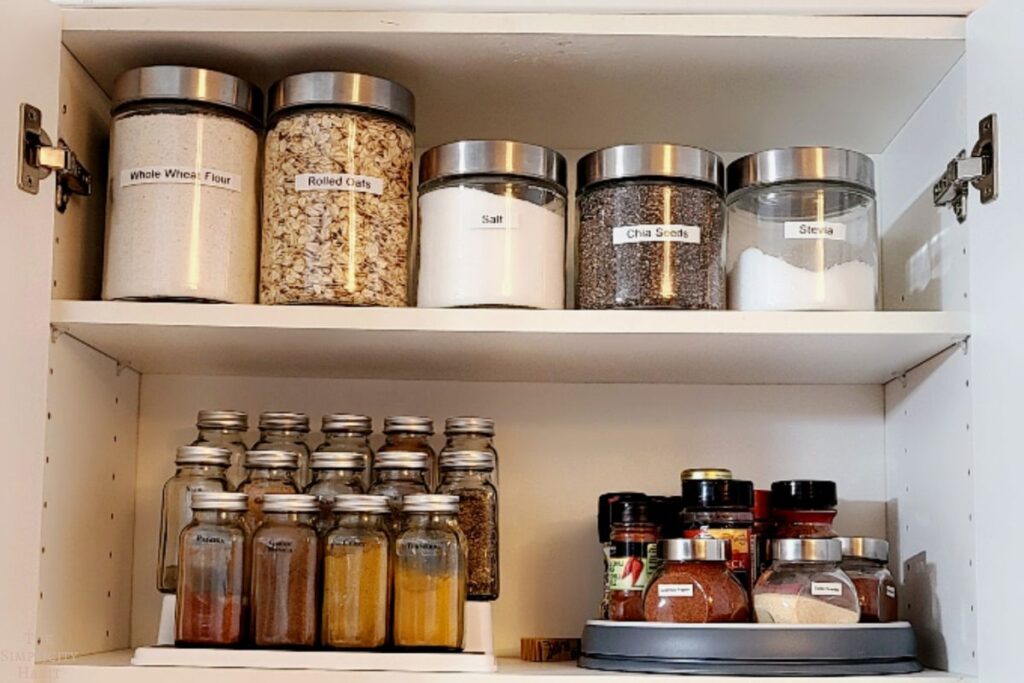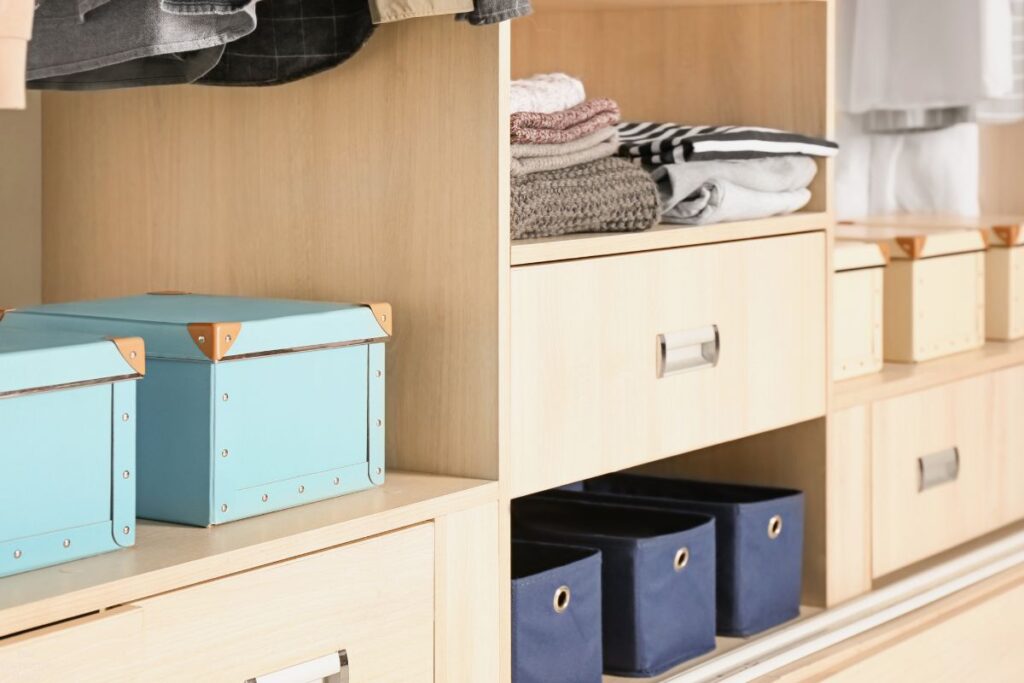Inside: Use this ultimate guide to organizing your home to start the process of getting your home decluttered, cleaned, and organized.
Is your home the relaxing haven you’d hoped it would be?
While there are some things in our homes that may be beyond our control, such as small children making messes faster than you can clean them, there are other things that can be done to create a sense of calm.
By taking the time to declutter, clean, and organize you can make a space that is peaceful and that you’re happy to call home.
It’s so satisfying to have a neatly organized house where everything has its place and things are easy to find.
In fact, there are a number of advantages associated with having a well-organized home. In this post, we’ll explore the benefits of having an organized space and seven steps to help you get started in organizing your home.

5 Benefits of Organizing Your Home
Need some motivation to organize your home? Consider these five benefits.
1. You’ll save time.
How many times have you spent 10 minutes looking for your keys? Or 30 minutes looking for that paperwork you need? If your home is organized, those things will be easy to find and you’ll save yourself a lot of time and frustration.
2. You’ll reduce stress.
A cluttered, disorganized home can be a source of stress. When everything is in its place, you’ll feel more relaxed and less stressed.
3. You’ll be more productive.
If your workspace is organized, you’ll have fewer distractions so you can get down to business and be more productive.
4. You’ll have more fun.
A well-organized home is a more enjoyable place to be. You can actually enjoy being at home instead of feeling stressed out by the mess.
5. You’ll save money.
When you’re organized, you’re less likely to buy things you already have but can’t find. You’ll also save on late fees because you’ll be able to find things like bills and coupons.

7 Steps to Organizing Your Home
If you haven’t been in the habit of organization, getting your home to that point can feel like a daunting task.
This guide will walk you through the process step-by-step, showing you how to organize your home, create systems that work for you, and establish habits that will keep your home clean and organized for years to come.
1. Get rid of clutter.
The first step to organizing your home is to get rid of clutter. There’s no point in organizing things that you don’t use or need. Go through every room in your house and get rid of anything that you don’t love or use.
Organized clutter is still clutter, so don’t skip this important step of the process. Carefully evaluate what you want to keep and let go of the stuff you no longer want. The goal is to streamline your belongings so that you’ll only be organizing the things that you really use and value.
2. Deep clean each room.
Once you’ve decluttered your home, it’s time to give each room a deep clean. Get rid of any dirt, grime, or stains so that you have a fresh slate to work with.
There will never be an easier time than when your home is freshly decluttered.
Some cleaning tasks that are often overlooked can be tackled while deep cleaning. They include:
- Vacuuming thoroughly, including behind and under furniture
- Cleaning carpets and rugs
- Washing walls
- Cleaning ceiling fans
- Cleaning windows and window treatments
- Wiping down baseboards
- Cleaning light fixtures
- Dusting all furniture and belongings

3. Create a system for each room.
The key to maintaining an organized home is to have a system in place for each room. When everything has its own place, it’s much easier to keep things tidy.
Take some time to think about how you use each room and what kind of storage would work best for you. Would bins, baskets, or shelves be most helpful? What type of organization will you be able to maintain fairly easily?
Start by working with what you have and create a shopping list for any other organization tools you might need.
Since every home is different, your organizational system might look different than anyone else’s. Still, there are a few basic concepts to consider for each room.
In the Kitchen
A place for everything: Designate a specific space for everything in your kitchen, from pots and pans to spices and silverware. This will make it easier to put things away and find what you need when you’re cooking. Keep items close to where they’ll be used to make your time in the kitchen easier.
Pantry essentials: Keeping pantry staples like flour, sugar, and rice in clear containers can help you easily see when you’re running low. But you don’t feel like you need to decant everything (that’s an organizing myth and it doesn’t work for everyone).
Keep stock: Have a running inventory for pantry and freezer items so you know what needs to be used up and what you need to buy more of. This will help reduce food waste and save you money.
In the Bathroom
Personal items: Designate an area for each family member to store their toiletries. Assign each person a drawer or shelf for their things. This will help cut down on clutter and make it easier to find what you need.
Bathroom cleaning supplies: Store all of your cleaning supplies in one place so you can easily find them when it’s time to clean. You can keep supplies in each bathroom to make cleanup time simpler.

In the Bedroom
Closet: Start by decluttering your closet and getting rid of anything you don’t wear. Then, organize your clothes by type (shirts, pants, dresses, etc.) or by season. This will make it easier to find what you’re looking for when you get dressed in the morning.
Under the bed: Most people forget about the space under their bed, but it’s a great place to store out-of-season clothes or other belongings that you don’t use often. Invest in some storage bins to keep things tidy.
In the Home Office
Filing system: A filing system will help you keep track of important papers and documents. Color code each family member’s files so you can easily find what you’re looking for.
Desktop: Keep your desktop clear by designating a place for everything. Inboxes are a great way to sort and store paperwork. Use trays or desk organizers to store other office supplies.
Wall calendar: A wall calendar is a great way to keep track of everyone’s schedule. Use it to jot down appointments, birthdays, and other important events.
In the Living Room
Media storage: If you have a lot of movies, video games, or CDs, it’s important to have a place to store them. Media storage cabinets or shelves will help keep your living room looking neat and tidy.
Toy storage: If you have young children, toy storage is a must. Bins or baskets are great for storing toys so they’re out of the way but are still easily accessible.
In the Garage or Shed
Tools: Hang up tools like rakes and shovels so they’re off the ground and out of the way. This will make it easier to find what you need and keep your garage or shed organized.
Garden supplies: Store gardening supplies like fertilizer and potting soil in labeled bins. This will help you find what you need when you’re ready to plant.
Outdoor gear: Winter coats, boots, and other seasonal gear can be stored in plastic bins or on hooks to keep them organized and out of the way.

4. Put it all into practice.
Now that you have a plan for each room, it’s time to put your system into practice. Take some time each day to do a quick tidy-up, putting things back in their place as you go.
This will help prevent your home from getting too cluttered as well as maintain your organizational system.
5. Schedule regular decluttering sessions.
To keep your home organized in the long term, schedule regular decluttering sessions. Once a month, go through each room and get rid of any belongings that you no longer need or use.
This will help you stay on top of the clutter and prevent your home from getting overwhelmed.
6. Establish a cleaning routine.
In addition to decluttering, you’ll need to establish a cleaning routine to keep your home looking its best. Implementing some daily cleaning habits will help to make it feel less overwhelming.
Your routine might include vacuuming once a week, dusting weekly, and doing a deep clean once a month. Find a schedule that works for you and stick to it.
7. Get the whole family involved.
Maintaining an organized home is a lot easier when everyone pitches in. Talk to your family about your plans for organizing the house and assign each person some chores.
This will help lighten your load and make it more likely that your home will stay tidy. You and your family will all enjoy the peace that comes with a well-organized home.

More Tips for Organizing Your Home
For the best results, follow these additional tips for organizing your home:
1. Set aside time to get the house organized.
It might seem like a daunting task to organize your entire home but by making consistent strides toward your goal you can get there. And you’ll feel so much better once it’s done!
Depending on your schedule, you could try to tackle this task within a short timeframe or over months if your time and energy are limited. Be realistic with the time you have available and commit to continuing to work on the process.
2. Don’t be afraid to ask for help.
If you’re feeling overwhelmed, reach out to a friend or professional organizer for help. They can give you some great tips and help you get started.
3. Make peace with imperfection.
No one’s home is perfect, so don’t strive for perfection. Your organization system is supposed to work for you – not the other way around.
Aim for imperfect simplicity in your home and enjoy your space while also learning to relax.
Organizing your home will set you up for success in so many other areas of your life. With a little bit of planning and some elbow grease, you can get your home into tip-top shape quickly!
What’s your favorite tip for organizing your home? Share it in the comments section!
Sign up on the form below to get weekly decluttering and simplifying inspiration sent straight to your inbox. You’ll also get the free 8 Quick Wins for Decluttering Worksheet to help you start to simplify your life today.


Hi, Julianna! Re: cleaning. I find it easier to clean one room a day. For example, if I’m cleaning the living room, after everything is dusted and the floors are vacuumed and mopped, I start on one thing that I don’t get to all the time. If I cleaned one big leather chair last week, I do the second chair the following week, and the leather sofa the week after that. This works well for me and now I don’t feel as if I’m running from one room to the next and not really accomplishing anything. As a bonus, I never have to deep clean any room because it all gets done (eventually!)